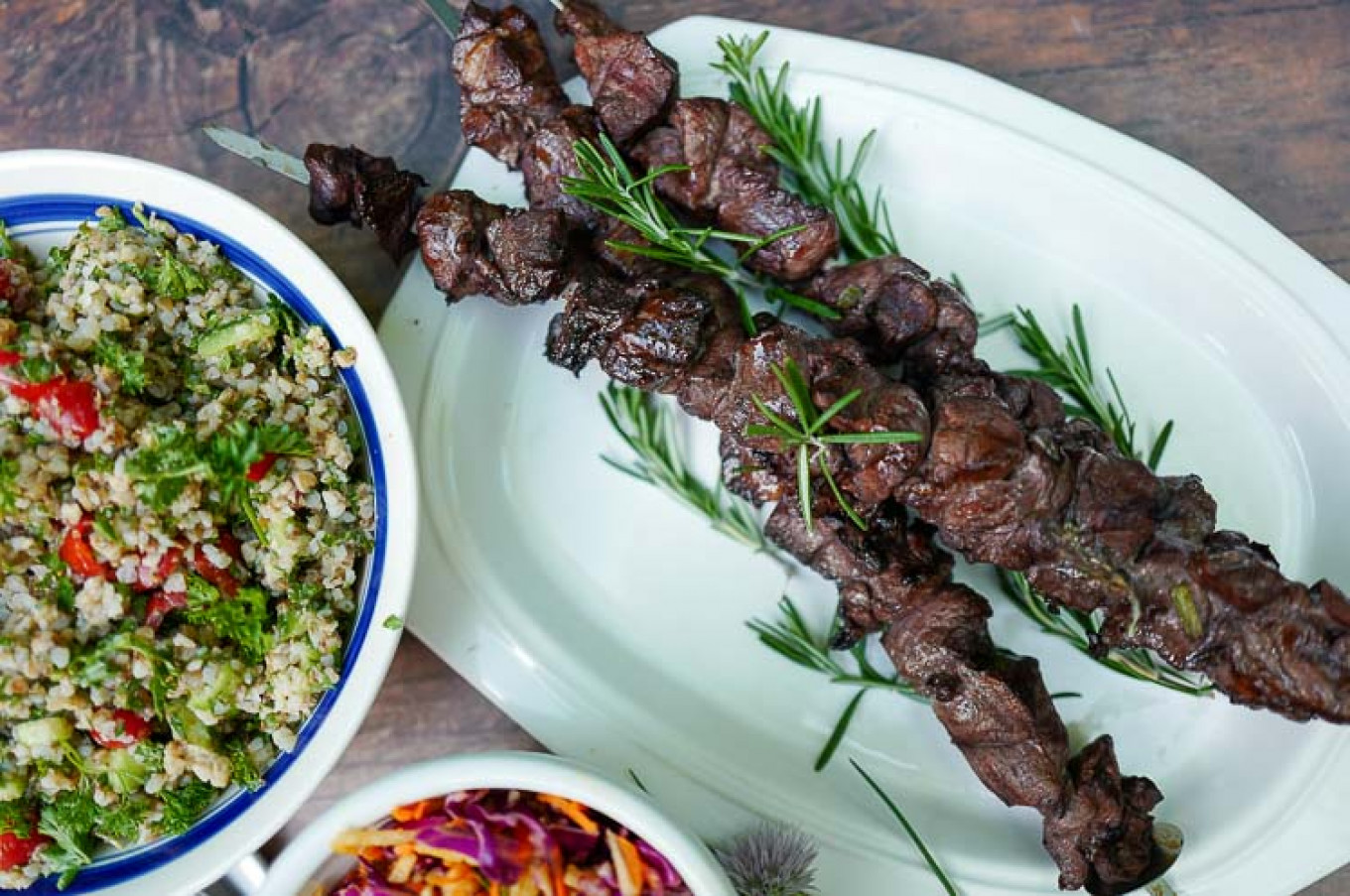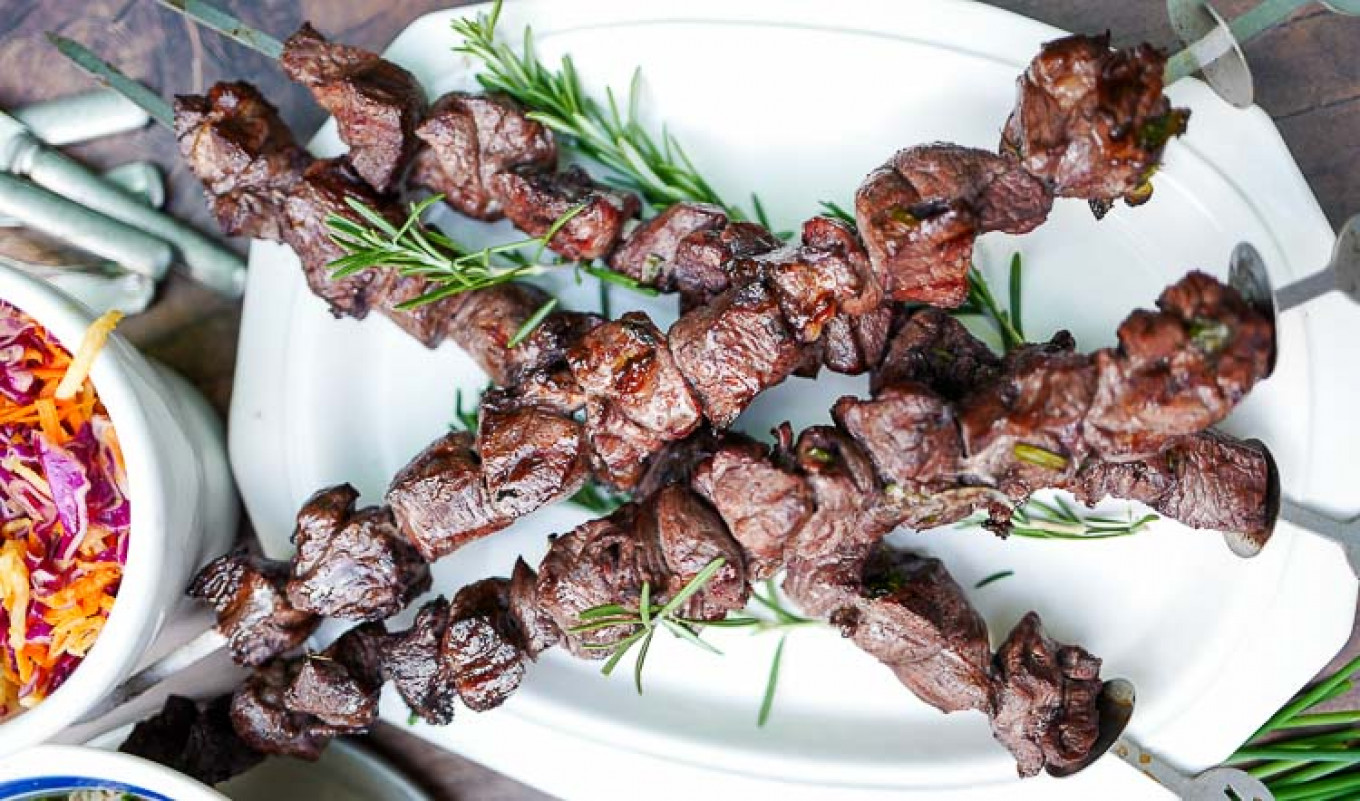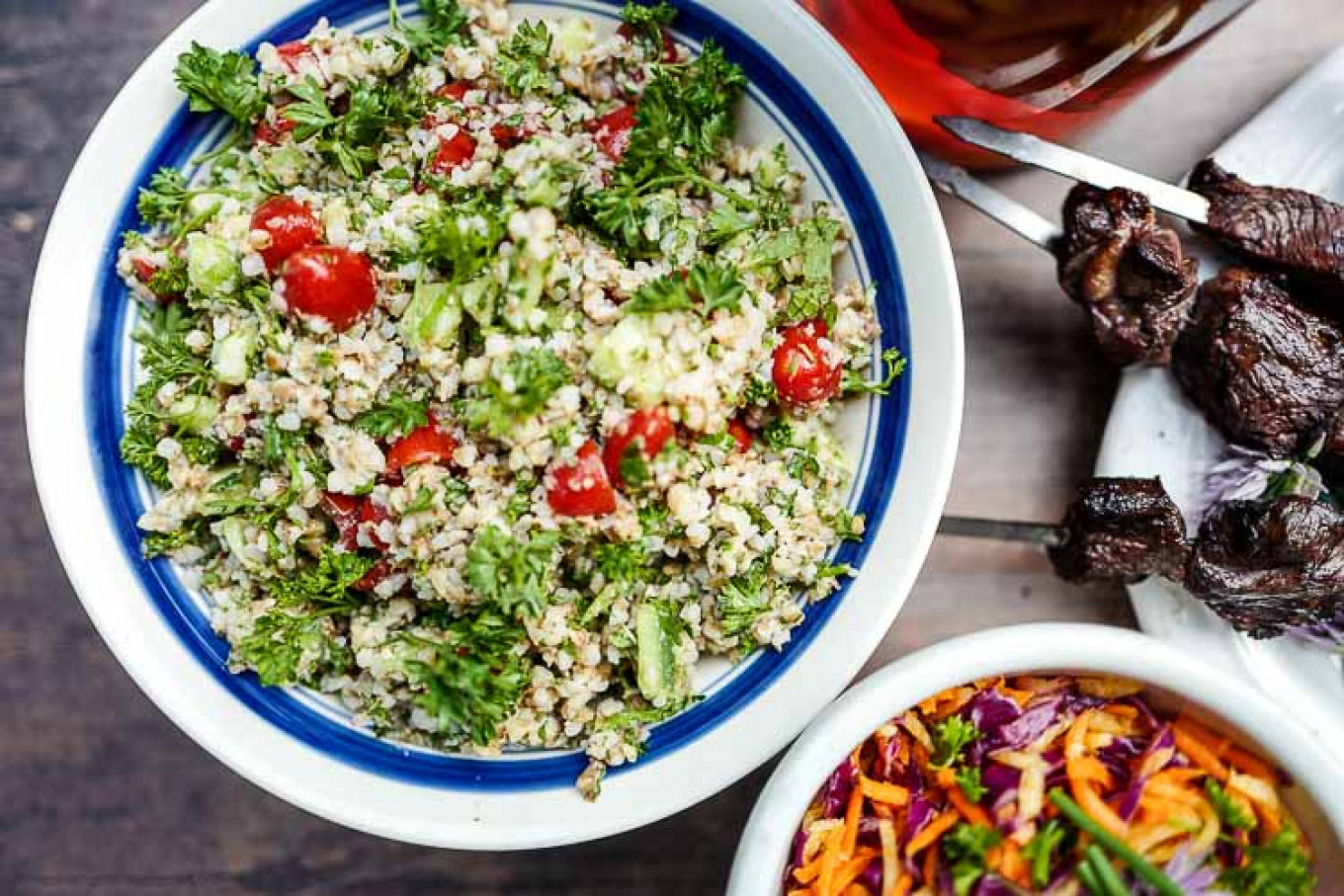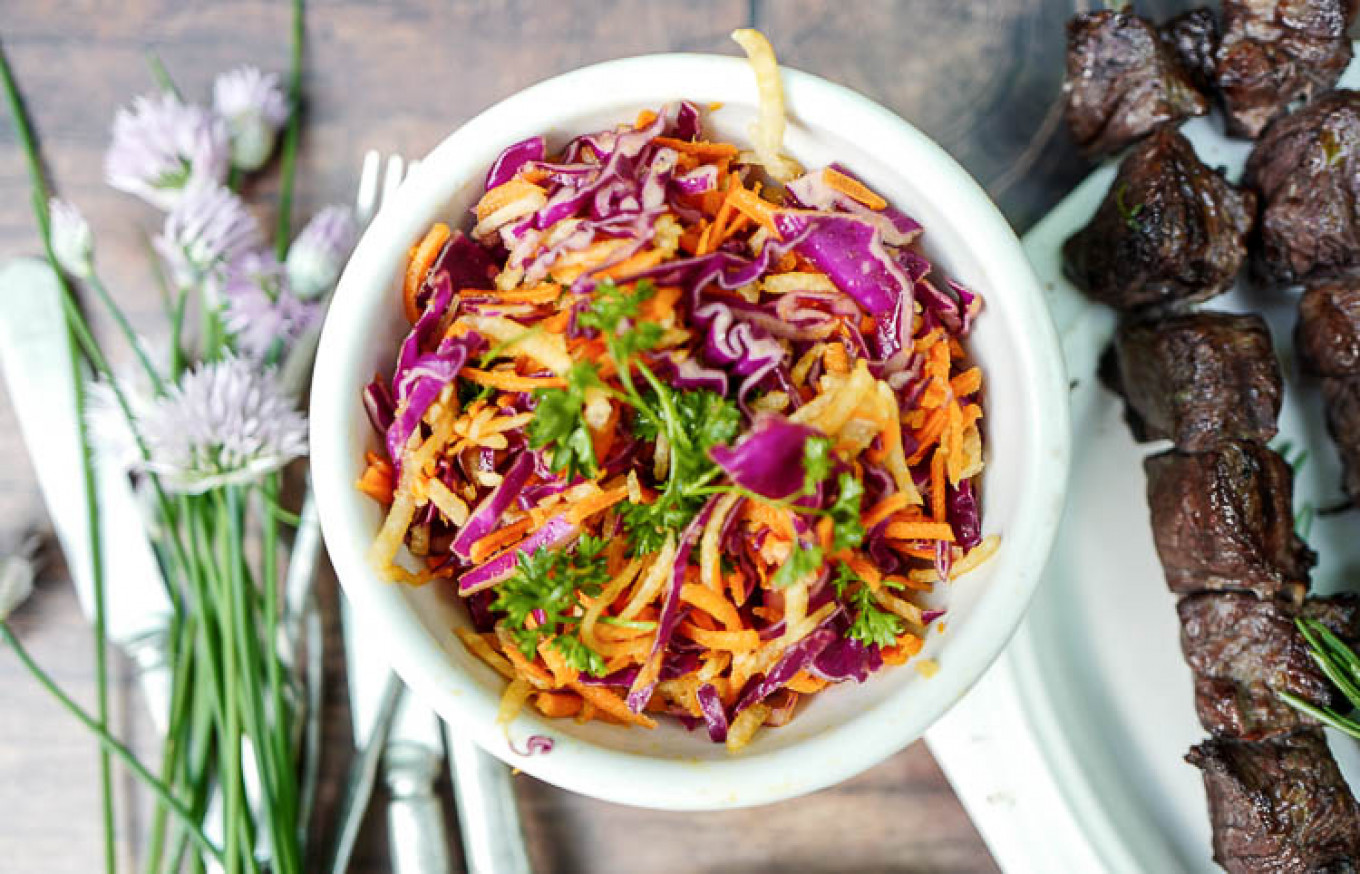Dacha season is upon us and the countryside beckons us with the enticing acrid smell of smoke from the wood burning open fire. Summers spent outside the city in a wooden dacha are an integral part of the rhythm of Russian life, a welcome respite from the urban hustle, necessitating a slower pace that entreats us to relax and savor the simple pleasures of long light evenings, fresh air, and al fresco dining around a communal table with friends and family.
The two great pillars of dacha cooking are an open fire and fresh, local ingredients. Dacha hosts worth their salt have long ago (ideally two or three generations ago) secured access to a reliable source of fresh dairy, meat and poultry for shashlik — what other cultures calls shish kabob — from a neighboring farm. Salad makings such as cucumbers, cabbage, carrots, tomatoes, new potatoes, runner beans, and herbs are hopefully growing in the kitchen garden or from that of an obliging neighbor across the fence.
The fulcrum of a dacha dinner is the shashlik skewer. This age-old form of marinating then barbequing meat on a stick came to European Russia centuries ago from Central Asia and has become a fundamental part of Russian cuisine. Russian men revere the preparation and execution of shashlik in the way Freemasons treat their secret lodge rituals, jealously guarded and seldom confided. “Shashlik,” Russian men say, shooing us weaker vessels away with the hand that isn’t clutching vodka, “does not tolerate women’s touch.”
This, of course, makes cracking the shashlyk code an irresistible challenge.
And to be honest? It wasn’t that hard. After almost two decades of surreptitious sleuthing around the fire, I can reveal that the secret sauce contains vinegar, oil, salt, some fresh herbs, and chopped onion. So, occasionally, just to chip away at the patriarchy, I dabble in mixing up the shashlyk marinade myself.
What can and should tolerate a woman’s touch are dacha side dishes. Classic dacha cuisine tenants dictate fresh garden vegetables consumed in their purest form: whole cucumbers just off the vine, ripe tomatoes sliced in half, and stalks of fresh tarragon, mint, and green onions. To keep dinner at the dacha from getting monotonous, I’ve used basic shashlyk building blocks with sides that feature fresh garden produce with light, tangy dressings.

Dacha Party #1
Signature Cocktail: The Rhozé: Rhubarb and Rosé fizz
Lamb shashlik marinated in red wine with rosemary and chives
Buccouli
Central Asian Slaw
Rhozé — Rhubarb and Rosé Cocktail
Frozé — that illicit relationship between rosé wine, ice, and various exotic sweet liqueurs — is this year’s “frozen concoction that helps us hang on.” It’s all the rage in hip rooftop bars, but a bit too technical for the dacha, involving as it does both ice and blenders. But I reached into the deepest recesses of my fridge where I keep my experiments and pulled out a jug of rhubarb cordial and began to play around to see how it might play with the rosé. The result is a cocktail that is pretty and potent enough to play with the Frozés, but low maintenance enough for the dacha! Feel free to use pink champagne to give it some fizz!
Ingredients:
- 4 oz (120 ml) dry rose
- 1 oz (30 ml) rhubarb cordial (recipe follows)
- 1 oz (30 ml) vodka
- 1/3 cucumber, peeled and seeded, then cut into slices
- Two bunches of mint
- Slice of grapefruit, preferably pink, or fresh strawberries for garnish
Instructions:
- Muddle half of the cucumber and all but a few leaves of the mint in the bottom of a cocktail shaker. Fill the shaker one-third of the way.
- up with ice, then add the rhubarb cordial and vodka. Shake vigorously to combine.
- Strain the liquid into a white wine glass. Add the remaining cucumber and mint, lots of ice, then pour the rose over the mixture. Garnish with pink grapefruit.
Rhubarb Cordial
Ingredients:
- 1 pound (500 grams) rhubarb, cleaned and cut into small chunks
- 2 cups (475 ml) sugar
- 2 cups (475 ml) water
Instructions:
- Combine the ingredients in a heavy-bottomed saucepan, stirring to combine. Bring the mixture to a simmer, stirring to ensure that the sugar dissolves.
- Once the sugar is dissolved, turn off the heat, cover the saucepan and let steep for 1 hour.
- When the mixture has come to room temperature, decant the mixture into a clean glass jar with a wide mouth.
- Cover and set in a cool, dry place for 72 hours. Strain and decant into clean glass bottles. Refrigerate.

Lamb Shashlik with Red Wine, Rosemary, and Chives
Ingredients:
- 3 lbs. (1.5 kilos) of lamb, shoulder or leg, cut into 2-inch (5 cm) chunks
- 3 cups (700 ml) red wine
- ⅓-cup (80 ml) red wine vinegar
- ⅓-cup (80 ml) olive oil
- 3 Tbsp salt
- 2 Tbsp whole coriander seed
- Three sprigs fresh thyme
- Two stems fresh rosemary
- Two anchovy fillets
- Six garlic cloves, peeled and sliced
- One bunch of fresh chives, roughly chopped
- Fresh chives and rosemary for the garnish
Instructions :
Marinate the lamb 12-24 hours in advance
- Place the lamb, fresh herbs, anchovy fillets, and garlic in a non-reactive bowl or plastic bag.
- Whisk together the remaining ingredients, then pour over the meat.
- Cover with plastic wrap and refrigerate for at least 4 hours ideally overnight.
- Turn or occasionally stir to ensure that all the meat comes into contact with the marinade.
Skewer the lamb
- Bring the meat to room temperature, then impale the chunks onto metal shashlyk skewers, taking care not to crowd the meat.
- Note that you can use wooden skewers, but soak them in salt water overnight to make them fire-resistant.
Onto the grill
- Grill the skewers over hot coals, approximately 4 minutes per side.
- Serve immediately, garnished with more fresh rosemary and chives.

Buccouli
I first learned of Buccouli from its inventor, Katrina Kollegaeva of Produkt, and immediately fell in love with the concept. This riff on tabouli, the ubiquitous Middle Eastern bulgur salad made from fresh garden vegetables and lashings of fresh mint, is now my go-to side for lamb shashlik. Katrina brought tabouli into the Russian fold by making it with buckwheat, and like bulgur has a nutty umami flavor, which makes a very satisfying contrast to the dominant tartness of lemon juice, fresh parsley, and mint.
This salad should be made well ahead of time to allow the grain to soak up the dressing.
Ingredients:
- 1-½ cups (350 ml) buckwheat groats
- 1/4-cup (60 ml) olive oil
- 4-cup (60 ml) vegetable oil
- Three lemons (Uzbek or Meyer lemons work particularly well in thissalad!)
- One tsp sugar
- Salt and pepper
- One large bunch of curly parsley, finely minced
- One large bunch of fresh mint, finely minced
- 3 cups (700 ml) cherry tomatoes, sliced in half, and de-seeded
- 3 cups (700 ml) young cucumbers peeled and cut into a fine dice
- Sumac
Instructions:
Prepare the buckwheat
- Place the buckwheat groats in a fine mesh colander and run coldwater over them for about 3 minutes.
- Place the buckwheat groats in a heavy-bottomed pan over medium heat. Add a generous pinch of salt and toast the groats for5 minutes.
- Pour 3 cups of cold water into the pan and bring to a simmer.
- Reduce the heat to low, cover, and simmer for 15-20 minutes.
Prepare the dressing
- Cut two of the lemons in half and place them, cut side down on a skillet over medium heat. Allow them to “char” for ten minutes.
- Remove and let cool to room temperature before squeezing the juice (use a strainer to catch any seeds) into a glass bowl.
- Whisk together the lemon juice, oils, sugar, and a generous pinch of salt and several grinds of pepper.
Dress the buckwheat
- The groats are done when they have absorbed all of the water.
- Turn off the heat and let the pot sit, covered, for an additional 10 minutes to allow the steam to “fluff” the buckwheat.
- Add three-quarters of the dressing to the groats and toss to combine.
- Set aside for at least one hour to allow the buckwheat to come to room temperature and absorb the dressing.
- Don’t worry if the salad seems soupy — the grains are very absorbent.
Assemble the salad
- Toss the tomatoes and cucumbers with the buckwheat, adding remaining dressing if the salad is on the dry side.
- Then toss in the parsley and mint.
- If possible, chill the salad for an hour to allow the flavors to combine. Just before serving, sprinkle with sumac squeeze the last lemon over the salad.

Central Asian Slaw
Shashlyk and slaw is a match made in heaven, each providing a ying to the other’s yang; crunchy meats chewy, umami meets sweet and sour,pungent meets acidic. The ingredients suggested below can be swapped out for anything fresh from the garden that can be easily shredded or spiralized.
Ingredients:
- One small head red cabbage, shredded
- Three carrots, peeled and shredded or spiralized
- One green apple or jicama, peeled and shredded or spiralized
- One bunch green onions/scallions, cut thinly on the diagonal
- One bunch fresh chives, minced
- One bunch fresh cilantro leaves removed from stems
- One bunch of fresh mint, finely minced
Garnish
- Fresh pistachios, toasted
- Whole coriander seeds, toasted
- Sesame seeds, toasted
For the dressing
- ¼-cup (60 ml) rice wine vinegar
- ¼-cup (60 ml) red wine vinegar
- ⅓-cup (80 ml) Asian fish sauce
- ¼-cup (80 ml) soy sauce
- ¼-cup (80 ml) honey
- ¼-cup (80 ml) sesame oil
- Three cloves garlic, finely minced
- One large knob of ginger, peeled and finely minced
- Juice of 1 fresh lime
Instructions:
- Toss the cabbage with a tablespoon of salt, and set it in a colander over a draining board or plate for one hour to soften the cabbage.
- Place the dressing ingredients in a large, clean glass jar with a tight-fitting lid. Shake to combine.*
- Drain the cabbage and pat dry with paper towel.
- Toss together with the carrots, apples and/or jicama, andscallions, and then pour a bit more than half of the dressing on.
- Toss vigorously to combine, adding more dressing as needed.
- Add the fresh herbs just before serving with a bit more dressing.
- Toast the pistachios, coriander and sesame seeds in a hot skillet until they begin to smoke.
- Remove from heat and cool for 4 minutes before scattering on top of the slaw.
*The dressing will keep up to 4 days in the refrigerator
Jennifer Eremeeva is a longtime expat who writes about Russian cuisine, history, travel, and culture. Follow her @JWEremeeva.
A Message from The Moscow Times:
Dear readers,
We are facing unprecedented challenges. Russia's Prosecutor General's Office has designated The Moscow Times as an "undesirable" organization, criminalizing our work and putting our staff at risk of prosecution. This follows our earlier unjust labeling as a "foreign agent."
These actions are direct attempts to silence independent journalism in Russia. The authorities claim our work "discredits the decisions of the Russian leadership." We see things differently: we strive to provide accurate, unbiased reporting on Russia.
We, the journalists of The Moscow Times, refuse to be silenced. But to continue our work, we need your help.
Your support, no matter how small, makes a world of difference. If you can, please support us monthly starting from just $2. It's quick to set up, and every contribution makes a significant impact.
By supporting The Moscow Times, you're defending open, independent journalism in the face of repression. Thank you for standing with us.
Remind me later.







